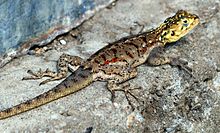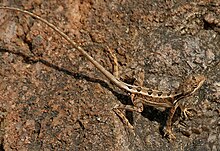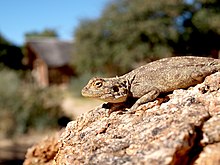Agamidae
| Agamidae Temporal range:
| |
|---|---|

| |
| Male Mwanza flat-headed rock agama (Agama mwanzae), in the Serengeti, Tanzania | |
| Scientific classification | |
| Domain: | Eukaryota |
| Kingdom: | Animalia |
| Phylum: | Chordata |
| Class: | Reptilia |
| Order: | Squamata |
| Suborder: | Iguania |
| Clade: | Acrodonta |
| Family: | Agamidae Gray, 1827[1] |
| Subfamilies | |
|
6, see text | |
Agamidae is a family of over 300 species of iguanian lizards indigenous to Africa, Asia, Australia, and a few in Southern Europe. Many species are commonly called dragons or dragon lizards.
Overview
Phylogenetically, they may be sister to the Iguanidae, and have a similar appearance. Agamids usually have well-developed, strong legs. Their tails cannot be shed and regenerated like those of geckos (and several other families such as skinks), though a certain amount of regeneration is observed in some.[2][3] Many agamid species are capable of limited change of their colours to regulate their body temperature.[4] In some species, males are more brightly coloured than females,[5] and colours play a part in signaling and reproductive behaviours.[6] Although agamids generally inhabit warm environments, ranging from hot deserts to tropical rainforests, at least one species, the mountain dragon, is found in cooler regions. They are particularly diverse in Australia. [7][8][9]
This group of lizards includes some more popularly known, such as the domesticated bearded dragon, Chinese water dragon and Uromastyx species.
One of the key distinguishing features of the agamids is their teeth, which are borne on the outer rim of their mouths (acrodonts), rather than on the inner side of their jaws (pleurodonts). This feature is shared with the chameleons, but is otherwise unusual among lizards, but is shared with the tuatara. Agamid lizards are generally diurnal, with good vision, and include a number of arboreal species, in addition to ground- and rock-dwellers. Most need to bask in the sun to maintain elevated body temperatures, meaning they are heliothermic. They generally feed on insects and other arthropods (such as spiders), although for some larger species it may include small reptiles or mammals, nestling birds, flowers or other vegetable matter in their diets.[10]
Reproduction
The great majority of agamid species are oviparous.[11] The eggs are mostly found in damp soil or rotting logs to retain enough moisture during the incubation period. The clutch size varies from 4-10 eggs for most species, and incubation period lasts from around 6-8 weeks. Specifically in the Leiolepidinae subfamily of agamids, all species use a burrowing system that reaches moist soil and this is where eggs are deposited in late spring/early summer or at the beginning of the dry season. The Leiolepidinae burrow system is also used for daily or seasonal retreats as it allows them to regulate their body temperature or acts as a refuge from predators.
Systematics and distribution



Very few studies of the Agamidae have been conducted. The first comprehensive assessment was by Moody (1980)[12] followed by a more inclusive assessment by Frost and Etheridge (1989).[13] Subsequent studies were based on mitochondrial DNA loci by Macey et al. (2000)[14] and Honda et al. (2000)[15] and also by sampling across the Agamidae by Joger (1991).[16] Few other studies focused on clades within the family, and the Agamidae have not been as well investigated as the Iguanidae.
The agamids show a curious distribution. They are found over much of the Old World, including continental Africa, Australia, southern Asia, and sparsely in warmer regions of Europe. They are, however, absent from Madagascar and the New World. The distribution is the opposite of that of the iguanids, which are found in just these areas but absent in areas where agamids are found. A similar faunal divide is found in between the boas and pythons.[17]
Subfamilies
Among the Agamidae, six subfamilies are generally recognized:[18][19]
- Agaminae (Africa, Europe and south Asia)
- Amphibolurinae (Australia and New Guinea, 1 species in Southeast Asia)
- Draconinae (South and Southeast Asia)
- Hydrosaurinae (Hydrosaurus, Papua New Guinea, the Philippines, and Indonesia)
- Leiolepidinae (Leiolepis, Southeast Asia)
- Uromasticinae (Saara and Uromastyx, Africa and south Asia)
Evolutionary history
The oldest known unambiguous agamid is Protodraco from the mid-Cretaceous (early Cenomanian) aged Burmese amber of Myanmar, dating to around 99 million years ago. It is similar to primitive living Southeast-Asian agamids.[20] Gueragama from the Late Cretaceous of Brazil may also be an agamid.[21] Jeddaherdan, a supposed agamid from the Late Cretaceous of Morocco, was later shown to be actually a young subfossil of the living genus Uromastyx.[22]
Predator responses
Body temperature helps determine the physiological state of these lizards and affects their predator responses. There is a positive correlation between a flight response (running speed) and body temperature of various agamid species.[23] At higher body temperatures, these lizards tend to flee quickly from predators, whereas at lower temperatures where they tend to have a reduced running speed and show an increased fight response, where they are more likely to be aggressive and attack predators.
Certain physical features of some lizards of these species, such as frilled-neck lizards, play a role in their defensive responses as well. During the mating season, males tend to display more of their frill, and give fight responses more often. Both males and females display their frill when they are threatened by predators, as well as during social interactions.[24]
References
- ^ Dahms Tierleben. www.dahmstierlrben.de/systematik/Reptilien/Squamata/Iguania/agamidae.
- ^ Thompson, M.B. (1993). "Estimate of the population structure of the e[a]stern water dragon, Physignathus lesueurii (Reptilia : Agamidae), along riverside habitat". Wildlife Research. 20 (5): 613–9. doi:10.1071/WR9930613.
- ^ Ananjeva, Natalia B.; Bryan L. Stuart (2001). "The Agamid lizard Ptyctolaemus phuwtilmensis Manthey and Nabhitabhata, 1991 from Thailand and Laos represents a new genus". Russian Journal of Herpetology. 8 (3). Folium Publishing Company: 165–170.
- ^ de Velasco, Jesus Barraza; Glenn J. Tattersall (September 2008). "The influence of hypoxia on the thermal sensitivity of skin colouration in the bearded dragon, Pogona vitticeps". Journal of Comparative Physiology B. 178 (7): 867–875. doi:10.1007/s00360-008-0274-8. PMID 18491114. S2CID 13413178.
- ^ Cuervo, J.J.; R. Shine (10 July 2007). "Hues of a dragon's belly: morphological correlates of ventral coloration in water dragons". Journal of Zoology. 273 (3): 298–304. doi:10.1111/j.1469-7998.2007.00328.x.
- ^ LeBas, Natasha R.; N. Justin Marshall (2000). "The role of colour in signaling and male choice in the agamid lizard Ctenophorus ornatus". Proceedings of the Royal Society of London B. 267 (1442): 445–452. doi:10.1098/rspb.2000.1020. PMC 1690562. PMID 10737400.
- ^ Gray JA, Sherratt E, Hutchinson MN, Jones MEH (2019). "Changes in ontogenetic patterns facilitate diversification in skull shape of Australian agamid lizards". BMC Evolutionary Biology. 19 (1): 7. doi:10.1186/s12862-018-1335-6. PMC 6325775. PMID 30621580.
{{cite journal}}: CS1 maint: multiple names: authors list (link) CS1 maint: unflagged free DOI (link) - ^ Gray JA, Hutchinson MN, Jones ME (2019). "Exceptional disparity in Australian agamid lizards is a possible result of arrival into vacant niche". The Anatomical Record. 302 (9): 1536–1543. doi:10.1002/ar.24096. PMID 30773845.
- ^ Gray JA, Sherratt E, Hutchinson MN, Jones ME (2019). "Evolution of cranial shape in a continental‐scale evolutionary radiation of Australian lizards" (PDF). Evolution. 73 (11): 2216–29. doi:10.1111/evo.13851. PMID 31580481. S2CID 203652748.
- ^ Cogger, H.G. (1994). Reptiles and Amphibians of Australia. New South Wales: Reed. ISBN 978-0-7301-0088-1.
- ^ Bauer, Aaron M. (1998). Cogger, H.G.; Zweifel, R.G. (eds.). Encyclopedia of Reptiles and Amphibians. San Diego: Academic Press. pp. 134–136. ISBN 978-0-12-178560-4.
- ^ Moody, S. M. (1980). Phylogenetic relationships and historical biogeographical relationships of the genera in the family Agamidae (Reptilia: Lacertilia) (PhD). Ann Arbor: University of Michigan. 8017324.
- ^ Frost, Darrel R.; Richard Etheridge (28 September 1989). "A phylogenetic analysis and taxonomy of iguanian lizards (Reptilia: Squamata)". University of Kansas Museum of Natural History Miscellaneous Publications. 81. University of Kansas Museum of Natural History: 1–65. Retrieved 5 January 2012.
- ^ Macey, J. Robert; James A. Schulte II; Allan Larson. (2000). "Evolution and phylogenetic information content of mitochondrial genomic structural features illustrated with acrodont lizards". Systematic Biology. 49 (2): 257–277. doi:10.1093/sysbio/49.2.257. PMID 12118408..
- ^ Honda, Masanao; Hidetoshi Ota; Mari Kobayashi; Jarujin Nabhitabhata; Hoi-Sen Yong; Showichi Sengoku; Tsutomu Hikida (2000). "Phylogenetic Relationships of the Family Agamidae (Reptilia: Iguania) Inferred from Mitochondrial DNA Sequences" (PDF). Zoological Science. 1991 (3): 616–622. doi:10.2108/0289-0003(2000)17[527:PROTFA]2.0.CO;2. ISSN 0289-0003.
- ^ Joger, Ulrich (1 August 1991). "A Molecular Phylogeny of Agamid Lizards". University of Kansas Museum of Natural History Miscellaneous Publications. 81 (3). American Society of Ichthyologists and Herpetologists: 616–622. JSTOR 1446389.
- ^ Heads, Michael (2014). "3 Global affinities of Australasian Groups §Indian + Pacific Ocean Groups". Biogeography of Australasia: A Molecular Analysis. Cambridge University Press. p. 119. ISBN 9781107041028.
- ^ Agamidae, UniProt Taxonomy
- ^ B. Ananjeva, Natalia (October 2010). "Asian Agamid lizards (Agamidae, Acrodonta, Sauria, Reptilia): Phylogenetic and taxonomic diversity". Taprobanica: The Journal of Asian Biodiversity. 2 (2): 65. doi:10.4038/tapro.v2i2.3144.
- ^ Wagner, Philipp; Stanley, Edward L.; Daza, Juan D.; Bauer, Aaron M. (August 2021). "A new agamid lizard in mid-Cretaceous amber from northern Myanmar". Cretaceous Research. 124: 104813. doi:10.1016/j.cretres.2021.104813. S2CID 233704307.
- ^ Apesteguía, Sebastián; Daza, Juan D.; Simões, Tiago R.; Rage, Jean Claude (September 2016). "The first iguanian lizard from the Mesozoic of Africa". Royal Society Open Science. 3 (9): 160462. Bibcode:2016RSOS....360462A. doi:10.1098/rsos.160462. ISSN 2054-5703. PMC 5043327. PMID 27703708.
- ^ Vullo, Romain; Bailon, Salvador; Dauphin, Yannicke; Monchot, Hervé; Allain, Ronan (November 2022). "A reappraisal of Jeddaherdan aleadonta (Squamata: Acrodonta), the purported oldest iguanian lizard from Africa". Cretaceous Research: 105412. doi:10.1016/j.cretres.2022.105412.
- ^ Hertz, Paul E.; Huey, Raymond B.; Nevo, Eviatar (1 August 1982). "Fight versus flight: Body temperature influences defensive responses of lizards". Animal Behaviour. 30 (3): 676–679. doi:10.1016/S0003-3472(82)80137-1. ISSN 0003-3472. S2CID 53182102.
- ^ Shine, Richard (May 1990). "Function and evolution of the frill of the Frillneck Lizard, Chlamydosaurus Kingii (sauria: Agamidae)". Biological Journal of the Linnean Society. 40 (1): 11–20. doi:10.1111/j.1095-8312.1990.tb00531.x.
External links
 Media related to Agamidae at Wikimedia Commons
Media related to Agamidae at Wikimedia Commons Data related to Agamidae at Wikispecies
Data related to Agamidae at Wikispecies- Agamidae (all species) at The Reptile Database
- "Agamidae". Atlas of Living Australia.
